


Cerro Gordo County Iowa
Part of the IaGenWeb Project
|
The Globe Gazette


TRANSCRIBER'S NOTE: Some of the language contained in these news articles are not considered to be politically correct by today's standards. They have, however, been transcribed as they appeared in 1953.
1904: HELP CELEBRATE BIG PURCHASE [Section 5, Page 2] Old timers will remember 1904 for the song hits, "Little Egypt" and "Meet Me in St. Louis," and for the fact that was the year St. Louis staged the world's far to commemorate the 150th anniversary of the Louisiana Purchase. It was on April 30, 1803, that Napoleon sold to the United States more than a million square miles in the middle of the country for a paltry $15 million. The St. Louis celebration was given ample space in the Globe-Gazette that year, opening as it did on April 30 and continuing until December. A number of Mason Cityans went to the big event. Many historians regard the Louisiana purchase as the third greatest event in America's history, with the signing of the Declaration of Independence and the drawing up of the Constitution as other big events. Being a part of the Louisiana Purchase, Iowa regards it as a most significant transaction.
FEDERAL AVENUE BRIDGE
(My apologies - I tried to enhance this photograph so it was clearer and easier to see, but it was originally dark from the scan. ~ SRB)
STARTED SHOE BUSINESS 50 YEARS AGO
1905: PASTOR BECOMES POLICEMAN [Section 5, Page 2] During the period when Mason City underwent its giant industrial expansion with the accompanying growing pains some complaints arose that the city government wasn't giving sufficient attention to law enforcement. One of the leading pulpiteers in the city at that time was Dr. W. W. Carlton of the First Methodist Church, whose membership during this period reflected the big population growth. In these days Dr. Carlton spoke plainly from the pulpit about having men in office who would enforce the law. A new mayor, A. W. Dawson, had just taken office in 1905 and Dr. Carlton went to his office to assure him that he would stand back of a law enforcement regime. He found several men in the office seeking appointments. The mayor finally turned to him and said: "Well, what office do you want?" "I'd like to be road commissioner," replied the minister, jokingly." "No," said the mayor, "bit I think I'll put you on the police force." There were more laughs. Dr. Carlton left and thought no more about it. Then when the fair was in progress and extra police were needed, the mayor called the pastor to his office, gave him a star and appointed him on night duty. The minister filled the post to the credit of the service.
The big world news of 1905 was the announcement that the czar had made Russia a "free country." In October of that year the Globe-Gazette carried news dispatches to the fact that the czar had granted a "constitutional monarch" and agreed to call the Duma (parliament) into session. Then came the unsuccessful revolution of November, 1905, in which were displayed the Red flags that later were to become so prominent.
1906: HATHORNS OPERATE FIRST GARAGE
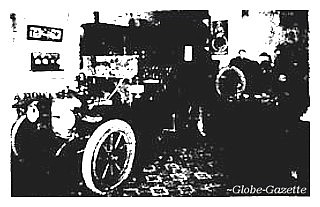
[Section 5, Page 2] Mason City's first automobile sales and service - the forerunner of scores that were to follow - was the Hathorn Auto Company, started in 1906 by two brothers, William H. and Charles Hathorn, on the present [1953] site of the Ideal American Laundry on First and Washington S. W. [The Hathorns sold the first Cadillac and Buick cars in Mason City.] The year 1906 saw other important developments, notably the construction of the plant of the Northwestern States Portland Cement Company. For a brief period before the Hathorn auto business was launched - from the time the first strange specimens of the gas and electric buggies started appearing in 1902 - automobile mechanical services had been provided in the machine shop and foundry established by the Hathorn brothers' father H. W. Hathorn, back in 1890 on 2nd S. W. The elder Hathorn came to Cerro Gordo County in 1878 and devoted his early years to farming, while at the same time operating a shop on his farm. The demands for a machine shop in Mason City led him to move his shop with its power windmill to this community. In time his sons helped him in the shop. Charles and William continued to operate their garage, expanding with the times. In 1914 Charles Hathorn left to join the fast developing airplane industry, in which he had been interested. He is now [1953] engineer in charge of all patents for all plants of the Curtiss Wright Airplane Corporation. W. H. Herreman of Clear Lake claims to have the first automobile in Cerro Gordo County, a single cylinder, called dash Oldsmobile. It looks like a buggy with bicycle tires. The car was purchased in Waterloo and driven through Mason City to Clear Lake and then to Herreman's farm north of Clear Lake. "Everyone in the whole country thought I was the incarnation of the devil," said Herreman, later describing his drive from Waterloo. "There was hardly a soul I met who didn't tell me that he thought I was a law violator, frightening horses and people as I did. "But it was not all one-sided. The car had to mind one law that made travel difficult. That law was that when the car approached a driver and horses from the front or rear, he was obliged to stop the car and help the horses around it if the drive of the horses raised his hand." The same year Willis Babcock of Mason City bought the second car in the county, a two-cylinder Haynes Apperson. About the same time Josh Melson, building contractor, got a National Electric. Charles Lighter of the Milwaukee Railroad purchased the first steam car in Mason City. H. W. Hathorn purchased a Locomotive Steamer in 1903. There was no license fee on cars the first year, 1902. The following year it became necessary to pay $3 for a license. The numbers were not made on a plate but were of aluminum tacked on the bodies of the cars.
NOTE: In 1910 officers of Hathorn Automobile Company were Charles E. Hathorn, president; William H.
Hathorn, secretary and treasurer. It later moved to the Federal Building on Fourth Street in 1912.
During the summer months the company employed a corps of ten men. Hathorn were agents for the sales of the Stevens-
Duryea, the E. M. P., the Flanders, White cars and trucks, Packard, Electric Passenger cars,
Willys Knight, Whippet and the Chalmers automobiles. The business moved to 109-11 First S. E.
In December of 1919 Charles sold his interest to his brother William. In 1931, William and his son, W. B. Hathorn
formed the Hathorn Motor Parts Co. and moved to 105 First S. E. They supplied dealers in a nine county area with
parts for passenger cars, trucks, tractors and miscellaneous industrial equipment as well as auto accessories with a
service station and garage tools and equipment.
NOTE: Charles Edward Hathorn was born December 6, 1879, Clear Lake, Iowa,
and died May 21, 1955. His wife Hazel L.
(Jones) Hathorn was born December 29, 1890, and died May 29, 1955. They were interred at Clear Lake Cemetery.
100 Years at "The Clothing Corner of North Iowa" [Section 5, Page 3]

The corner of State and Commercial (Federal) was a muddy crossing in 1869 when the first railroad came to Mason City and when the above picture was taken. The one story building, just across the street south from Central Park, upper right hand corner, occupied the spot that later was to become known as the "Clothing Corner of North Iowa."
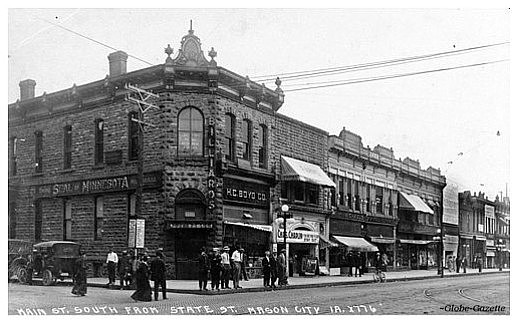
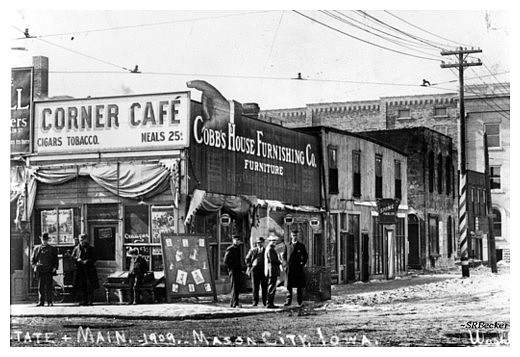
In 1909 this corner was occupied by the Corner Cafe where you could buy cigars, a good meal for 25-cents and oranges for 20-cents a dozen. The corner cafe was also known as the "Yellow Spot." Even then this was the popular corner of the town . . . destined to become more famous as the years rolled by. This structure remained on the corner until 1910.

The corner was to undergo its first major change in 1910 when world famous Frank Lloyd Wright was retained to design the building as pictured above. It was originally designed and housed the City National Bank. Wright himself described the structure as "designed with the idea that a bank building is itself a strong box on a large scale." This structure became world famous.
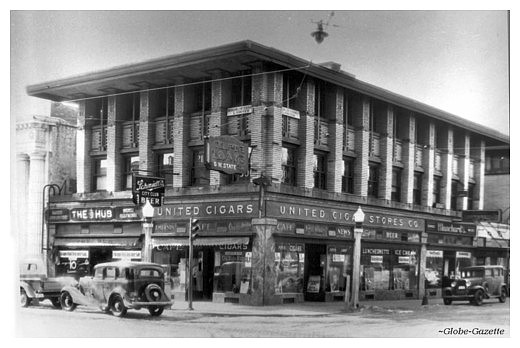
The year of 1926 marked the return of the Weir Building, as it was known, to the family when it was purchased by A. A. Adams in that year. It was remodeled into a store and office building. The United Cigar Store occupied the corner of the main floor until 1932 when the entire main floor was again remodeled [illegible] . . . "The Clothing Corner of North Iowa."

From 1934 until the fall of 1952, the Hub corners occupied one-half of the first floor. In 1952 they began an extensive remodeling program to include the entire corner main floor giving Mason City one of the best men's stores in the Middle West. This new store [illegible] as tomorrow and offers leading brands in Men's Clothing [illegible] CLOTHING CORNER OF NORTH IOWA, State and Federal.
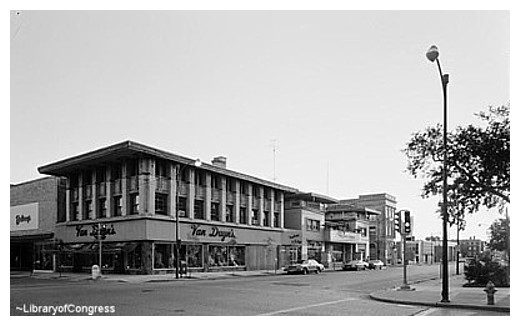

BOUGHT SCHOOL in 1906
[Section 5, Page 4] Ward R. Hamilton in 1906 purchased the controlling interest in the Toland Business
School here, which then became the Hamilton School of Commerce, with Hamilton as president. The school was started
by F[rank]. J. Toland of Lacrosse, Wis., in 1900, on the third floor of the Damon store building. Hamilton became identified
with the school as fieldman in 1904 and the following year became an instructor.
1907: FIRST PTA RAISES PIANO FUND [Section 5, Page 4] From the time of its organization in 1907 the Parent-Teachers Association has had a vital role in the life of this community. The first group to be organized on that early date was the Garfield PTA, with Mrs. George Warner as president. One of the first projects of the group was a supper at which 400 persons were served at 25 cents each. The proceeds from the project made it possible to buy the first piano for the school. Mrs. Warner was succeeded as president by Mrs. Belle Carle and Mrs. H. N. Newell. Soon PTA's were organized at the other schools. The national organization of parents and teachers took root in Washington, D.C., just 10 years before the first branch was established in Mason City. The group was incorporated 3 years later, in 1900, as the national Congress of Mothers and Parent-Teachers Associations and in 1924 it assumed its identity as the National Congress of Parents and Teachers. The first city-wide organization in Mason City developed in 1918 when the council was formed at a meeting in the high school. The first council, which is in the nature of a governing body for the loosely-federated bodies throughout the city, named Mrs. Harold Spears, now of Chicago, as the first president. Mrs. Spears was followed in office by Mrs. C. E. Dakin, then by Mrs. W. R. Mickey. It was during Mrs. Mickey's term of office that the first free textbooks were issued to school children. This measure was taken largely through the insistence of the PTA council, which procured the co-operation of the school board and then bent its energies toward creating sufficient sentiment for the measure to secure its enactment at the next election.
PANORAMA of BUSINESS DISTRICT in 1907

Looking North, East and South from State and Federal
PIONEER BUSINESS MEN
The two brothers were together in the clothing enterprise until 1919 when W. L. Patton started the real estate, insurance and investment business, which is still operated as the W. L. Patton Company [Later known as Mason City Loan & Investment Company operating out of the ground floor of the M.B.A. Building]. After continuing in the clothing business for some years, C. R. Patton retired from business and served for many years as Cerro Gordo County supervisor. W. L. Patton was one of the dominant figures in the revival of the Cerro Gordo County Fair in 1908 at which reorganization of the association took place and plans made for the purchase the following year of the acreage, which has served as fair grounds for the past 45 years. C. R. Patton will observe his 92nd birthday this year and W. L. Patton will be 90 years next November. They were born in Clinton, N. Y., and came to Mason City with their father in 1870, a few months after the arrival of the first railroad. Their first job was herding cattle on the prairies. NOTE: William Lincoln Patton died November 8, 1954. His wife Anna (Lyon) Patton was born in 1868, Rockford, Iowa, and died June 3, 1933. They were interred at Memorial Park Cemetery, Mason City.
1908: COUNTY FAIR MOVED to NEW GROUNDS
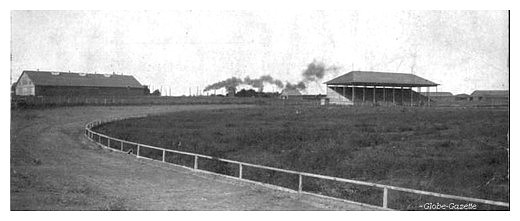
[Section 5, Page 4] From the time of the first settlers in Mason City business men have had it as a policy to do something more for their rural neighbors than selling him merchandise. It was a Mason City business man, W. L. Patton, who took the leading role in reviving and reorganizing the Cerro Gordo County Fair in 1908. The previous fair organization had faded away for lack of interest. Its accessibility led to the purchase of the present site. The street railway provided the best mass transit for Mason City people. Dan McArthur of Lime Creek was elected president; W. L. Patton, vice president; L. G. Stevens, Mason Township, treasurer; and C. E. Somers, Mason City, secretary. Getting the fair under way was not without difficulties. The day before the fair was to open the contractor informed the executive committee he would have to have his money before he could turn over the keys to the buildings. The committee signed a joint note for $4,500. A few years alter when infantile paralysis appeared in Mason City just before the opening of the fair, the attendance dropped and officials were $1,500 short of being able to pay the premiums, so 15 directors up up $100 each. Emphasis was placed on enlarging the activities of the fair, setting as the aim the encouragement of greater productivity of the land, development of finer livestock, a higher level of living on the farm, the training of boys and girls and the enlarging of the exhibits to include an industrial show. Backers of the fair had now reached the conclusion more than ever before that the fair belonged to the people the same as churches and schools and that persons taking stock in the organization should never expect a dividend. A bill was introduced in the Legislature enabling counties to become stockholders in fair associations and allowing them to contribute a portion of tax money for their support. Charles H. Baker for many years served in the double capacity of secretary of the Retail Merchants Association and of the North Iowa Fair. In 1918 the Le Mars Printing Company, which had been started at Le Mars in 1853, the year the first cabin was built in Mason City, was moved to Mason City. Associated in the firm at that time were B. F. Ferguson, M. E. Ferguson and Rolland Duffield.
It was in1908 that Ray Seney started the jewelry business in Mason City that still bears his name and which is now owned and operated by his son, Ray Seney Jr. NOTE: Daniel McArthur was born June 29, 1857, and
died November 7, 1913, interment made at Elmwood-St. Joseph Cemetery.
TAFT HERE in 1908
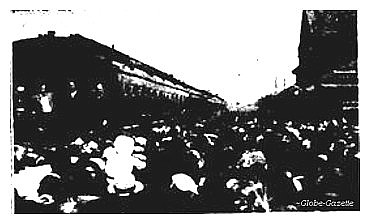
[Section 5, Page 4] William Howard Taft made two visits to Mason City. The picture above shows him at the Milwaukee station Sept. 26, 1908, while on his campaign to be elected President. After serving as President, he was in Mason City again, this time to speak at the dedication of the MBA (Brick and Tile) June 6 and 7, 1917.
1909: PARK HOSPITAL is STARTED HERE HERMANSON BROTHERS BEGIN DAIRY BUSINESS
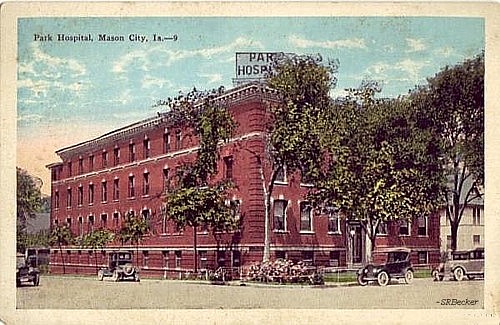
[Section 5, Page 6] Two important establishments were started in Mason City in 1909 - the Park Hospital and the Hermanson Dairy. The Park Hospital was organized by Drs. Starr, W. E. Long, C. M. Swale, Fred Albert and Charles L. Marston. It was situated in the Times Building until the present building was completed in 1911. In 1918 the hospital purchased the house to the north for a nurses home. Later this was made a part of the hospital and another building acquired for the nurses home.
Ten days after the second wagon was started Johnnie's team ran away. He was injured and spent the next three months in the Story Hospital. Meanwhile Herman kept the dairy going operating from the O. T. Balmat farm north of Mason City. Later the brothers acquired the Kennedy dairy on the rear of a lot at 808 Delaware N. E., where they have continued since, erecting a new plant. The volume of business continued to expand until the plant became one of the largest in this section of the state. NOTE: Johnie A. Hermanson Sr. was born in 1890, and died in 1983. His wife Margaret E. Hermanson was born in 1897, and died in 1968. Herman Alexander Hermanson was born July 15, 1891, St. Paul, Minnesota, and died May 25, 1961. His wife Ruby Roberta (Crawford) Hermanson was born February 3, 1896, Rockford, Illinois, and died may 11, 1985, Mason City. They were all interred at Elmwood-St. Joseph Cemetery. Hermanson Dairy was purchased by Carnation Company in 1954. [Section 5, Page 5] 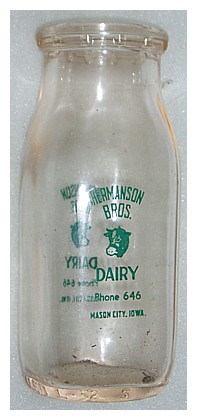

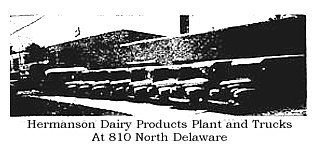

_____________________ THE HERMANSON DAIRY STORY
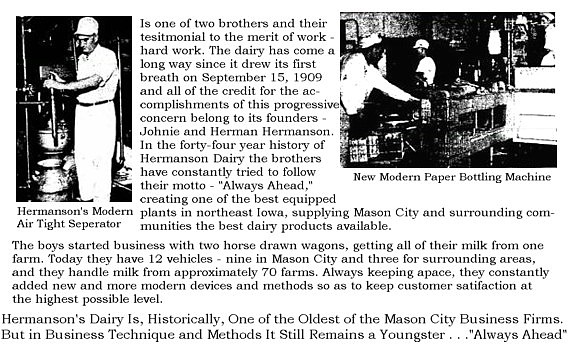
HOLY FAMILY CHURCH in 1909
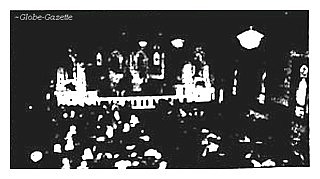
[Section 5, Page 6] Holy Family Catholic parish was organized in 1908 and in 1909 the church was built at 110 2nd N.W., the interior of which is shown above.
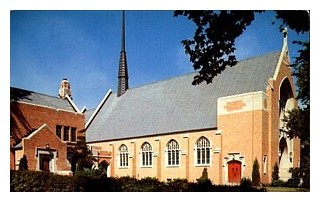
1910: HIGH COURT SETS LAKE LEVEL [Section 5, Page 6] The Iowa Supreme Court on March 9, 1910, handed down a decision on setting the level of the waters in Clear Lake and thus ending a half century old feud between two groups of property owners on the lakeshore. A natural outlet on the east side of the lake, consisting of a narrow and easily altered embankment, was the center of the controversy. This outlet formed the beginning of Willow creek, which flows on through Mason City. Almost from the time Joseph Hewitt and James Dickirson selected a site on the south shore of the lake for their home in 1851 the outlet had been tampered with until no one knew its original level. In the early days settlers took rock out of the outlet for cabin foundations. The fight between those who wanted a high shoreline and the farmers whose lowland meadows were flooded reached such a commotion that in 1903 the county supervisors built a concrete sluiceway at the outlet. But instead of settling the matter, this was like waving a red flag to both factions. When the 1905 vacation season opened 22 cottage owners asked an injunction against the supervisors, claiming they had unlawfully constructed an outlet from "18 to 24 inches below the natural level of Clear Lake." The supervisors added two heavy plank to the sluiceway raising the water level 26 inches. On the early morning of Oct. 25, 1905, Clear Lake residents heard a terrific explosion. Investigation revealed the cement banking and board apron of the outlet were ripped to pieces. The identity of the person who set off the blast was never revealed. A court action was filed asking that the board be enjoined from interfering with the outlet or the flow of water. The State of Iowa filed a petition of intervention, alleging ownership of the bed of the lake and asking it be authorized to erect and maintain the permanent embankment, headgate and sluiceways to retain the lake at high water level. The supervisors then stepped out of the case and the trial got underway in the courthouse at Mason City. Witnesses on one side or the other were landowners around the lake, seeking either to raise or lower the level of the water. The two groups were 3 1/2 feet apart in their claims, one side contending the water should be 30 inches above and the other, a foot below the concrete sluiceway. The best legal talent in the county was arrayed on both sides. This momentous trial did an number of things besides fixing the water level of Clear Lake. It put on record much of the early history of Clear Lake, including the rise and fall of the waters and occasional efforts of the settlers to regulate this.
The testimony of old timers showed the lake had regular cycles of high and low water. From 1857 to the time of the trial there were three periods of high levels. The first of these began in 1857 and reached the highest point about 1860. The second high water period was in 1878 and 1879. The third began to manifest itself in 1903 reaching its highest level in 1905 when the trial started. Between these high water periods were corresponding intervals of lower water levels. The question to be settled in the trial was "What was the level of the outlet when the white man first put in his appearance." One of the contentions of the plaintiff was that the natural bank of the lake at the outlet had been tampered with. Not only the settlers but the elements had a part in changing the outlet. In 1860 the lake tore out part of the embankment and a mil race. The fear that the entire lake would pour through the embankment down Willow Creek and flood Mason City 10 miles down the stream led a large part of the population of the community to rush to Clear Lake and aid in re-building the bank. The evidence in the trial was that the bank "was put back where it was" after this event. There was also testimony that in 1891 Major R. S. Young of Clear Lake strengthened the embankment at the outlet. The history of an old camp meeting association at Clear Lake also entered the trial. The ground for this project was platted in 1887 and two pools called Siloam and Bethsaida included. Witnesses testified one could row from the lake into these pools in the early days but that since then this had been impossible. There was also evidence presented that the Charles Grimm slough, south of the lake was covered with water in the early days so that it was impossible for sail boats to go in. During the 60's a ditch was dug through a hill to Crovell's slough, draining the water into the lake when the water was low and to keep Grimm's land dry. But when the lake rose again the ditch caused the water to spread. Consequently Grimm and others similarly situated were interested in a low outlet. Among those testifying were Oscar Stevens, gristmill operator, who said every 14 years the lake goes through a high and low water cycle. He believed the outlet too low. This also was the testimony of Fred Sirrine, son of James Sirrine, one of the original settlers. Edwin Nichols said the water was higher in 1857 than he had seen it since. L. E. Crowell said the lake at the time of the trial was 12 inches below the highwater mark. Dwight Palmeter, Dr. J. B. Charlton and A. H. Green, all said the lake had been higher in earlier days. John C. Sherwin, a Supreme Court justice, said he believed part of the sluiceway had been removed. This also was the view of William Gilmore. W. S. Colby, county surveyor, testified the spillway was three feet below the old bank. Witnesses for the defense were chiefly farmers from the upper lake region, where the water was shallow. They all testified the lake had been higher in later years. D. H. Campbell, superintendent of schools, said the water had become so high that the ice had pushed out trees and even sidewalks. J. B. Wood, resident of Clear Lake since 1855, said the lake was a foot higher than he had ever seen it before. This also was the view of Michael Callanan, E. J. Schert, Jeno Frandson and others. At the conclusion of the trial, Judge J. F. Clyde held that the level of the county supervisors' sluiceway was the correct one. The state appealed to the Supreme Court, which handed down a decision ordering the outlet raised a foot.
"An examination of the record leaves no doubt but that the ground surface of the outlet as it formerly existed was considerably above the elevation decreed by the court," was the opinion of the state's highest tribunal. "A separate examination of the record has convinced us that the elevation of the outlet as compared with the datum bench mark at the southeast corner of Clear Lake should have been fixed at 190.23 inches instead of 189.23." Judge Sherwin took no part in the Supreme Court proceedings. Almost immediately after this decision the supervisors built a new sluiceway 12 inches above the old one. For more than 40 years now the water level has stood where the Supreme Court ordained it. No one has since tried to dynamite the new outlet. But the cycles of high and low water have continued.
The height of this concrete sluiceway, at Clear Lake outlet, which determines the level of the lake, was set by the Iowa Supreme Court in 1910 after a bitter court battle in Cerro Gordo County. The outlet flows into Willow Creek.
1911: FORM CIVIL LEAGUE MELSON PLATS RIVER HEIGHTS HERE MARSHALL, SWIFT and MILLWORK ORGANIZED [Section 5, Page 8] The platting of River Heights in 1911 was the first step in residential restriction in Mason City. The master mind of this project was John G. Melson, building contractor and real estate operator. The year 1911 saw other important developments, the completion of the six-story First National Bank Building and the start of such business enterprises as Marshall and Swift and the Mason City Millwork Company. That year also saw the beginning of the organization that is now the Mason City Women's Club. Melson came to Mason City from Pocahontas County, Iowa, and started work in the construction business with E. R. Bogardus, father of Mrs. W. G. C. Bagley. Later he entered the contracting business and built among other structures the Lincoln School (then the Mason City high school), the Congregational Church and the Central Trust building, five-story structure n the present [1953] site of the J. C. Penney Company store.
Melson's outstanding achievement was his buying and platting of River Heights. He succeeded in acquiring the area between 4th S. E. and Willow Creek, as far north as State. He platted the riverside properties with extraordinary care and established restriction to insure development that would make the fullest use of the natural beauty of the stream. NOTE: Joshua G. Melson was born in 1865, and died in 1945. Minnie (Spencer) Melson was born November 19, 1861, and died March 16, 1915. Julia T. Melson was born in 1887, and died in 1956. They were interred at Elmwood-St. Joseph Cemetery.
Women's organizations, prominent in the life of the community from early days, devoted their efforts to social activities, study and community betterment. Many a movement for civic improvements have come from women's organizations. Dominant group among the women for many years was the Mason City Women's Club. It had its origins in 1911 as the Civic League, described as a type of women's Chamber of Commerce, devoting its efforts toward improvement of home life and civic betterment. In 1922, when Mrs. C. H. McNider was president, the name was changed to Women's Club. Among the club's projects have been "making Mason City beautiful" campaigns, efforts to allay the smoke nuisance, fights against flies, modern sanitation and better housing. For years the club has operated with general programs of interest to all members and department meeting touching on many subjects of interest to the women of the community.
In 1927 the present building was erected on Delaware N. E. Later the laundry was added and finally, the fur department. The plant continued to expand. Marshall served for a number of years on the city council and also as mayor of Mason City under the city manager government. At present [1953] Carroll Swift, Charles D. Swift and D[on]. J. Marshall, sons of the founders, are carrying on the business.
NOTE: Arleigh J. Marshall was born October 5, 1889, and died September 12, 1950, interment made
at Elmwood-St. Joseph Cemetery.
A building was erected on the present site, Monroe and 4th S. W. in 1916. In 1921 a glazing room was added. In rebuilding the plant after a fire in 1922, a third floor was added. In 1936 the plant was further enlarged. A third brother, Fred Tubbesing, joined the company in 1921 after the death of his brother, Henry Tubbesing, becoming manager. In 1928 John W. Tubbesing moved to Mason City to head up the operation. His son-in-law, Carl Kluth, who came with the firm in 1936, is now vice president and general manager and Jay Tubbesing, son of Fred Tubbesing, sales manager. The company serves a territory extended from 100 to 150 miles of Mason City with all types of millwork and is the distributor for a number of additional products. During the war years the Mason City Millwork Company territory extended from Utah to Ohio as it provided products for war plants.
NOTE: Fred Tubbesing was born January 21, 1876, and died September 4, 1953. Jay M. Tubbesing
was born July 11, 1905, and died April 17, 1962. They were interred at Elmwood-St. Joseph Cemetery.
FIRST PIANO TRUCK
NOTE: Frank Kinhart was born August 5, 1871, and died May 21, 1918. Ella C. Kinhart was born March 12, 1868, and died February 21, 1958. Samuel J. "Sam" Kinhart was born November 15, 1895, and died August 24, 1917. They were interred at Elmwood-St. Joseph Cemetery.
LINCOLN SCHOOL BURNS
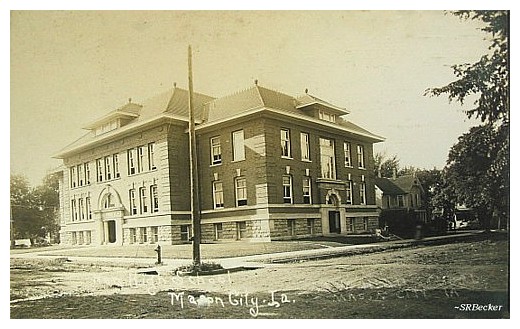
Globe-Gazette headlines of the day stated: "$80,000 FIRE IN MASON CITY HIGH SCHOOL - Was Struck By Lightning - Fine Large Structure Completely Destroyed by Flames This Morning --- Was Insured for $68,000 --- Loss is $80,000." The article stated: "Fire from a lightning bolt destroyed the $80,000 high school building here this morning, with a loss of $75,000. . . $18,000 of insurance had been but recently taken out and added to what insurance was previously on the building. The building was one of the finest of its kind in the state. In addition to the building, the large library and laboratory equipment was destroyed."
FIRST CHURCH of CHRIST SCIENTIST BUILDING
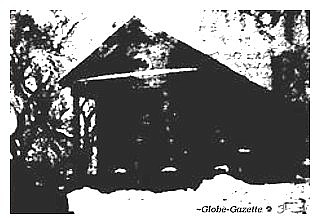
[Section 5, Page 9] This is the original church erected by the First Church of Christ, Scientist, on the rear of the lot on which the present church stands at Washington and Third N.W. It was built in 1901 and served the congregation until the new church was completed in 1928. NOTE: M. M. Moen Company architect Clyde W. Smith designed the 1928 church building, present [2014] address being 23 Third Street N.W. The building, currently serving as Courtside Offices, was added to the National Register of Historic Place on October 30, 1997.

STANBERY OFFICE FIRE INTERRUPTS MASONIC CEREMONY [Section 5, Page 9] When Ralph S. Stanbery was taking his Third degree as a member of the Benevolence lodge, Ancient Free and Accepted Mason, in 1911, the ceremony was interrupted. As Stanbery was in the midst of taking his obigation, the tyler sent in word that the building his family owned and in which his officers were located was on fire. The news was communicated to Earl Smith, the master, who stopped the ceremony permitting Stanbery to leave. The fire gutted the building, which was replaced almost immediately afterwards by a new building, the structure on northeast corner of the intersection of First and S. Federal, where Stanbery still [1953] continues to have his offices.
1912: DUNN GOVERNOR CANDIDATE
That was the year Theodore Roosevelt bolted the Republicans, and organized the Bull Moose Party, whose nominee he became to run against both the Republican and Democratic candidates. Four years before William Howard Taft, secretary of war under Roosevelt, had been nominated and elected President with the blessings of Roosevelt. But when Taft failed to follow the progressive policies of the Roosevelt regime, which had included the use of the Pig Stick and breaking up of trusts, Roosevelt decided to run against him. Defeated by what was vociferously referred to as steamroller tactics in the Republican convention, Roosevelt and his followers organized The Progressive party and nominated Roosevelt. The Democrats in a long drawn out convention nominated Woodrow Wilson, then governor of New Jersey. The political campaign that fall was characterized mostly by the battle between the two former Republican leaders, Taft and Roosevelt. With the Republicans thus split the Democrats won easily in the November election. Wilson got 435 electoral votes to 88 for Roosevelt and 8 for Taft. Mason City had an important role in this 1912 election with a native son as the Democratic nominee for governor in the person of E. G. Dunn, who already at that time had achieved wide acclaim for his ability on the platform. Dunn, who later rose to become the United States district attorney for the northern district of Iowa, was at that time secretary of the Farmers and Grain Dealers Association of Iowa, of which organization he became an eloquent platform spokesman. Through this organization and with Allan F. Beck as his campaign manager, Dunn carried on a campaign, first for the nomination and later for election. In the campaign for the nomination Dunn defeated John T. Hamilton, prominent Cedar Rapids banker, by several thousand votes. In the fall campaign Dunn was defeated by the Republican nominee, George W. Clark, by a margin of only 1,699. Clark's vote was 184,148 to 182,449 for the Mason Cityan. John L. Stevens, the Progressive candidate, got 71,770 votes. Despite the strength of the Republican party on the Iowa ticket, Wilson carried the state for the presidency. Dunn continued to be a power in the Democratic party and was a delegate to the Democratic national convention in 1932 when Franklin D. Roosevelt was nominated. In 1932 he was appointed United States district attorney, assuming the office on Oct. 1 of that year. His tenure of office was characterized by a large number of criminal cases that were prosecuted. These cases ran the whole gamut of federal law violations, from petty liquor matters with 30 day sentences to kidnapping charges in which the defendants were sent to Leavenworth for 20 and 25 years and life. NOTE: Edward G. Dunn was born in 1879, and died in 1948. His wife Laura (Delher) Dunn was born in 1889, and died in 1943. They were interred at Elmwood-St. Joseph Cemetery.
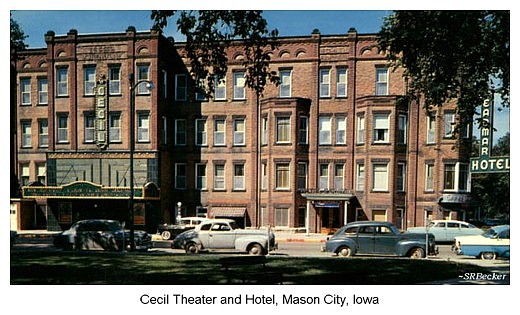
It was on June 3, 1912, that the new Cecil Theater was opened following the fire that destroyed the Wilson Theater on the same site. The opening was one that old timers still remember, with the brilliant show, "Pink Lady" as the attraction. Regular seats were $5 and choicer ones went as high as $25 each.
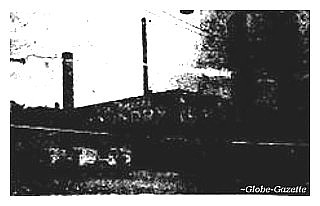
In 1912 the Ideal American Laundry was started in Mason City, the oldest institution of its kind still in existence in the city. NOTE: W. J. Holahan was the general manager of the Ideal American Laundry in 1929. ~ "Globe-Gazette" October 17, 1929.
FIRE STATION WAS COMPLETED in 1912 for GROWING CITY
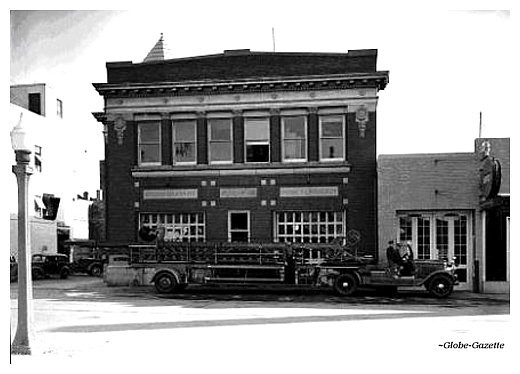
[Section 5, Page 9] The Globe-Gazette on Nov. 21, 1912, ran a lengthy page one story on the completion of the new fire station and happiness expressed by Chief Connors and his firemen over the facilities provided them. This represented another achievement in the efforts to modernize the department, which for many years was made up of volunteers.
SOCIALIST NEWSPAPER [Section 5, Page 9] The first issue of the Cerro Gordo Leader, a Socialist newspaper, made its appearance in Mason City on Nov. 30, 1912. It was sponsored by the Socialist Society of Mason City. The paper had financial difficulties from the first and soon suspended publication.
KNIGHTS of PYTHIAS BUILDING ERECTED [Section 5, Page 9] The story that work had started on the Knights of Pythias Building on East State made news in the Nov. 30,1912, issue of the Globe-Gazette. The building, the story stated, would have three floors. The editor in those days never dreamed that by the time the following decade had ended the building would be the property of the Globe-Gazette and house its offices and plant.
1913: FIRST AIRPLANE FLIGHT FIRST MILE OF RURAL PAVING LAID in COUNTY
That same year Sam Raizes opened up a store that became the nucleus of the present [1953] Sam Raizes Department store at 301 South Federal. The Raizes store grew with the city and today is in active charge of two sons of Mr. and Mrs. Raizes, Milton and Leon.
BENEFIT HELD for BOYS in SPANISH WAR [Section 5, Page 9] What was termed as "a benefit for our solider boys" in the Spanish-American War was held at the Parker's Opera House June 24, 1898. The program consisted of musical numbers and readings. A group of little girls gave the salute to the flag, Mrs. A. L. Long sang "The Star Spangled Banner" and W. E. Ensign presented a tableau, "A Thousand Years." Reading were given by Mrs. A. A. Adams, Miss Mabel Mosher and Mrs. W. G. C. Bagley. Phoebe Ara Reade gave a tableau of "Barbara Fritchie."
FROM ONE PIONEER to ANOTHER
[Section 5, Page 10] William H. and Charles (right) Hathorn of the Hathorn garage are shown making the delivery of a truck to the Currie Hardware Company in 1913, shortly before Charles left to become an engineer with the airplane industry.
LAST GLACIER WAS 10,000 YEARS AGO [Section 5, Page 10] It is generally agreed among the latest geological authorities that it is at least 10,000 years since the final retreat of the Wisconsin glacier - one of the last of the glaciers - from this part of North America. Assuming that the Wisconsin glacier would require an equal period of time for its total duration and that the interval between the Wisconsin and Iowan glaciers were at least 10,000 years, and it was probably much longer than that, by a reasonable approximation, 30,000 years is the age of the Shell Rock, as that stream dates from melting of the Iowa glacier.
TYPOGRAPHICAL UNION CHARTER SIGNED in 1900
Among the 18 members who signed that charter was Mrs. Helen Quick Dillon, sister of Herbert Quick, who lives at 219 6th N. E. The other charter members are: F. W. Roden, J. A. Russell, A. E. Harding, W. L. Woodward (for many years president of the Trades and Labor Assembly), E. Hitchcock, S. G. Mitchell, F. L. Whitney, W. A. King, H. A. Olson, W. E. Tucker, w. B. Terrill, Maude Russell, Saide Merriman, C. E. McEwen, H. E. Stanbery, H. E. Arquette and C. G. Van Wie.
1914: WORLD WAR STARTS in EUROPE [Section 5, Page 10] On July 28, 1914, the Globe-Gazette carried the story that Austria had declared war on Serbia. The news was a stunning blow to those who believed that some how the tensions created when Archduke Francis Ferdinand, heir to the Austrian throne, was murdered June 28, 1914, by Gavrillo, Bosnian Serb terrorist, in Sarajeva, Bosnia, would somehow be settled. Efforts for a peaceful settlement of the conflicting interests of Austria and Serbia were of no avail. The first days of August brought the main European powers into the conflict, into which the United States was to enter in 1917. It was in the summer of 1914 that Bill Pearce, race driver, with his Colby Red Devil, manufactured in the Colby Motor Company plant in Mason City, was killed in a Sioux City race. The death of the driver was symbolic of what was going to happen to the Colby enterprise, which next year went into receivership. NOTE: William Martin Colby, Mason City native, was involved early
in 1910 with the organization of the People's State Bank of Mason City. Appointed as a member of the board of directors,
Colby remained in this position until he began promoting the Colby Motor Company. His first car entered the public eye
on November 10, 1910. The Colby Motor Company held a
banquet on August 2, 1911 at the Hotel Cerro Gordo. Advertisements of the day priced the Colby Model H Five-Passenger
Fore-Door Touring car at $1,750. Competition, company mergers and reorganizations put an end to the Colby enterprise in 1914. 900 cars were manufactured
but very few have survived even though they were equipped with premium materials and an engine designed to endure an
Iowa winter. One car, carefully restored, is on display at the Kinney Pioneer Museum in Mason City.
Howard Elder started the Mason City Lumber Company in 1914. Born in Mason City in 1877, Elder has been a resident of Mason City his entire life. His sons, Don S. Elder and Charles D. Elder, are now active in the business. Before entering the lumber business Howard Elder was [a] salesman for a wholesale millwork company. He also had an interest in lumber yards at Lake Mills, Fertile and Clear Lake. David Olson, now of Burlington, Wash., was associated with him many years. NOTE: Howard S. Elder was born November 19, 1877, and died February 19, 1965. Donald S. "Don" Elder was born July 2, 1905, and died July 4, 1996. Charles D. Elder was born September 16, 1911, and died April 21, 1952. They were interred at Elmwood-St. Joseph Cemetery.
MASON CITYAN in BERLIN
NOTE: Dr. Stella May Mason was born in 1861 near Edgewood, Iowa. She received her B.S. and Master of Accounts degrees from Upper University in Fayette, Iowa. She taught for four years in New Hampton, Iowa and began her study of medicine under Dr. Amos Babcock, receiving an MD from Hanemann Medical College in 1893. After receiving her degree that year, Dr. Mason became the first female doctor and surgeon to practice in Mason City. Dr. Mason retired in 1843, the longest practicing physician [64 years] and only female physician in Mason city. She was serving as president of the Mason City's Woman's Suffrage Association when the 19th Amendment was passed. Dr. Mason received an honorary degree from Upper Iowa University in 1947. She died in Mason City on October 2, 1957 at the age of 96 years..
1915: LABOR ASSEMBLY FORMED [Section 5, Page 10] The Mason City Trades and Labor Assembly had its inception as the Central Labor Union, which received its charter from the American Federation of Labor Oct. 8, 1915. The charter was signed by Samuel Gompers, then president of the A.F. of L. and by William Green, then eighth vice president. The charter members were William H. Griebling, father of James Griebling, now president of the assembly; A. T. Cockayne, J. S. Wolford, J. D. Tally, H. H. Dull, J. M. Harris, C. L. Orcutt, J. C. Denny, Robert Gates, C. M. McComb and H. B. Kephart.
William H. Griebling was named the first president of the Assembly and for years was secretary-treasurer of the organization. He served as president of the Iowa State Council of Carpenters for 12 years, was secretary-treasurer of the Iowa Federation of Labor and traveled as organizer for the International Union. He was a member of the Iowa State Council of Carpenters for 12 years.
Also housed in the Labor Temple are the offices of the Building Trades Council, organized here in 1939, and the General Drivers Union Local No. 828, organized in the early 30's.
Heading the Trades and Labor Assembly at present [1953] is J. W. [James William] Griebling, son of the first president. Serving with him are: P. L. Broadwell, vice president; C. A. Lindsay, financial secretary; William VerHelst, recording secretary; P. Rickoff, Kenneth Holmland, Paul Hoye and William Lee, trustees; and E. E. McSweeny, sergeant-at-arms.
NOTE: William H. Griebling died September 18, 1934. Ida Elizabeth Griebling died May 14, 1948, They
were interred at Memorial Park Cemetery, Mason City. Oldest of the 24 unions affiliated with the Mason City central body is the Mason City Typographical Union No. 406, which was organized Dec. 27, 1900. Next is the Bricklayers and Masons No. 21, which was formed here Feb. 13, 1903. The Carpenters and Joiners No. 1313 came into existence July 18, 1910, and the Barbers Local No. 618, on Jan. 3, 1911.
The Plasterers and Cement Finishers were organized in 1937 and the Construction and General Laborers and the Painters, Decorators and Paper Hangers in 1938. The Mason City Fire Fighters No. 633 came into existence in 1939. Other affiliated unions are: Letter Carriers No. 471, Plumbers and Fitters Union No. 405, Cement Lime and Gypsum Workers Local No. 106, Women's Labor Auxiliary Local No. 6, and the General Drivers Local No. 828, Motion Picture Operators No. 45, Electrical Workers No. 431, Printing Pressmen No. 290, Musicians No. 230, Beet Sugar Workers No. 21468, Restaurant Employes (sic), Railway Carmen, Postoffice Clerks, Roofers and Sheet Metal Workers.
LABOR TEMPLE
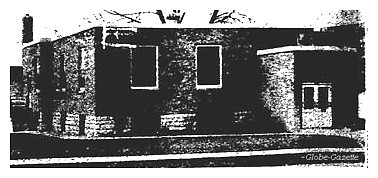
B. and P. W. CLUB STARTED HERE in 1915 [Section 5, Page 10] The Business and Professional Women's Club in Mason City had its origin on the evening of Feb. 18, 1915, when a group of Mason City girls met and organized the Business Girls Club. On the following Feb. 24 the constitution for the organization was adopted and Freda Kakuschke elected president. The club during this period had about 30 members and met twice a month. The club continued as an affiliate of the Mason City YWCA until it voted on March 28, 1920, to become an affiliate of the National Federation of Business and Professional Women's Clubs. It became one of the first clubs in the Iowa Federation of B.P.W. Clubs. Mason City was one of the six communities represented at the first state B.P.W. convention April 5, 1920, and Agnes Stevenson of the local club was elected a delegate to the national convention in St. Paul. In the early years the club was headed by Martha Pattie, Beulah Randolph, Lydia Barrette, Millie Daly, Kittie Lohr, Emma Hagenstein, Ruby Potter, Joy Ridgeway, Julia Potts, Dorothy Hamilton, Eva Scott, Maude H. Wepler and Elizabeth H. Graves. Over the years the club has engaged in numerous civic contributions, which has been widely recognized in the press. On one occasion a Globe-Gazette bouquet was given to the Business and Professional Women's Clubs of Iowa for formulating and making effective an admirable program of civic service.
1916: ROTARY CLUB, CHAMBER ARE ORGANIZED IDEAL SAND and GRAVEL STARTED [Section 5, Page 11] The Mason City Rotary Club is a unit in an organization that has clubs in nearly all the civilized countries in the world and in all of these the club ideal of good will, peace and service to others is dominate. The Mason City club was organized in 1916, 11 years after Paul Harris, a young Chicago lawyer, first conceived of the idea of such clubs. It was on May 29, 1916, that the permanent organization of the Mason City Rotary Club was completed and a list of 22 charter members was closed. The first officers were: Frank J. Hanlon, president; E. A. Hults, vice president; Elmer E. Pratt, secretary-treasurer; and C. H. McNider and Hugh H. Shepard, directors. Later Frank R. Currie and Ralph W. E. Decker were added to the board. During World War I the Rotary Club was conspicuous for its work in patriotic activities. Its field of service reached out to other areas, including work for crippled children, Boy Scouts and other assistance to boys and girls. It became the sponsor or backer of numerous civic projects. On Jan. 17, 1916, 50 business men met in the directors room of the First National Bank and took the first steps for the organization of the Mason City Chamber of Commerce. A Commercial club had existed for some years previous to this. Records of such an organization g back to 1908. The group called together in 1916 was headed by Mayor T. A. Potter, who appointed a committee consisting of Allen F. Beck, Ralph Decker, W. E. Gildner, Earl Smith and C. B. Sherman to set up the organization. By April 4 the organization was completed and the following officers elected: A. M. Schanke, president; W. A. Westfall, first vice president; C. B. Sherman, second vice president; and B. C. Way, treasurer. In the summer of 1916 Floyd Douglas of Fort Dodge was employed as secretary and from that time to the present the Chamber of Commerce has maintained a continuous organization with a paid secretary.
The plant was started in 1916 by Grant McGowen and F. A. Stephenson. In 1924 McGowan purchased Stephenson's interest and he and his family have since operated the plant, continuing to add new and modern machinery.
In 1926 Pauley purchased the entire business, which has since been operated as the Ray E. Pauley Company. In 1927 the company moved to its present location at 421-417 S. Federal and Jan. 1, 1950 was incorporated with Ray E. Pauley, president; Elvin G. Johnson, vice president; and John E. Pauley, secretary and treasurer. Johnson has been associated with the business since 1923. John Pauley entered the business in 1939.
NOTE: Ray E. Pauley was born in 1884, and died in 1954. He married in August of 1907 Pearl Markham
who was born in 1881, and died in 1972. They were interred at Elmwood-St. Joseph Cemetery.
MASON CITYANS on MEXICAN BORDER
Click on your browser 'back' button to return to this webpage. [Section 5, Page 11] Shown above is the 2nd Iowa Regiment, including A and D Companies from Mason City, which served on the Mexican border in 1916. The picture was taken at Las Balmas, near Brownsville, Tex., Jan. 26, 1917, shortly before the regiment returned to Iowa. In the row of officers in the foreground are Lt. Hanford MacNider, Capt. J. M. Heffner, Capt. Ory W. Garman and Lt. Con Helbig. The picture is the property of W. H. Paxton, a member of D Company. Shortly after returning to Mason City in March, 1917, the two local companies were mustered into service for World War I. NOTE: John M. Heffner died March 27, 1956. Wiffing H. Paxton was born December 27, 1897, and died February 3, 1990. They were interred at Memorial Park Cemetery, Mason City.
ROTARY CLUB MEMBERS

[Section 5, Page 11] Shown above are members of the Mason City Rotary Club in 1920 when W. F. Muse, Globe-Gazette editor, was president. From left are: First Row - Tracy M. Stevens, C. R. Patton, E. W. Clark, Maynard R. Tournier, William F. Murphy, Fred C. Eslick, Walter J. Walker, Frank D. Pearce, Ray E. Pauley, C. L. Kersey, Ralph W. Willis and Charles F. Brady; Second Row - C. H. Shaffer, W. F. Cody, Herbert Hirsch, F. J. Hanlon, C. H. McNider, Elmer E. Pratt, Charles W. Damon, W. F. Muse, W. H. Hathorn, C. B. Sherman, D. W. Grippen, J. D. Nichols, J. D. Evans and Eugene L. Balz; Third Row - Floyd Johnson, W. S. Wilcox, R. E. Boyle, W. H. Baird, W. E. Brice, M. E. Ferguson, L. A. Moore, B. C. Keeler, G. S. Holloway, H. M. Van Auken, H. B. Keeler, Jay E. Decker, the Rev. A. W. Tandy, F. T. Vasey, R. F. Armstrong, Roy F. O'Donnell, Frink C. Lovell, Dr. S. A. O'Brien, William McArthur, L. S. Thompson, Hugh H. Shepard and Andy O'Rear.
1917: TAFT DEDICATES MBA; RETAIL MERCHANTS ORGANIZE
Two months later in that eventful year, William Howard Taft, former president of the United States, was the speaker at the dedication of the Modern Brotherhood of America Building, now the Brick and Tile structure. The dedication program on June 6 and 7 also included an address by Gov. W. L. Harding. The year 1917 also saw the opening of the American Crystal Sugar Company plant, which was built the year before. W. H. Baird, father of Bil Baird, was manager and E. C. Moore, agricultural superintendent. NOTE: William Hall Baird was a chemical engineer and was married to Davenport, Iowa native Louise A. Baird, a graduate of Oberlin and was a pianist. The Baird family moved to Mason City in 1918.
After the death of Mr. Barber in 1940, Lester Milligan served as temporary secretary of the organization and the following year the promotional phase of the organization was joined with the Chamber of Commerce as the retail division. Shortly after Charles A. Schaffer became secretary-manager in 1948, the North Iowa Credit Guide was published, containing 30,000 names and about 70,000 credit ratings. The guide has grown to 40,000 names and more than 150,000 ratings. In January, 1951, Schaffer purchased the business from the merchants. Keith P. Crawford joined the organization the latter part of that year as sales manager. From April, 1917, when the Credit Bureau had only four files and 45 members, it has grown with Mason City to its present [1953] size of nine employes (sic), serving 350 business and professional men. The bureau has received many honors, winning various state, district and national awards. In 1952 it was voted one of the top bureaus in the nation and was second in the population bracket of 25,000 to 100,000 for the International Achievement Award. NOTE:
Albert J. Killmer was born July 18, 1875, and died August 19, 1936. Ted E. Winter was born August 6, 1878, and died June 7, 1932.
Lester H. Milligan was born March 12, 1893,and died July 12, 1988. His wife Vera L. Milligan was born August 17, 1894,
and died July 1, 1984. They were all interred at Elmwood-St. Joseph Cemetery.
1918: JUNIOR COLLEGE STARTS CLASSES; YWCA DEDICATED
World War II had come to an end and Mason City joined in the celebration, but months elapsed before the boys started coming back from "over there."
Not long after the Armistice, Mason City celebrated another important event, the dedication of the newly completed YMCA. This took place Nov. 24, 1918, marking the climax of a campaign that had started in 1913 when a group of Mason City business women wrote the national organization. The completion of the YWCA was in marked contrast with the YMCA, which was organized in 1893 and was not to enter a new building until 1927. At the opening of the school year in the fall of 1918 [September 8], classes got underway in Mason City's newly organized Junior College. Provisions for organization of Junior Colleges had been made in the 1917 session of the legislature. Both first and second year college instruction was provided with an enrollment of approximately 25 students. This beginning was to prove one of the city's fine achievements in education. The college was later accredited by the North Central Association of Colleges and Secondary Schools. Enrollment continued to grow until it reached a high of 300 after World War II and has since receded from that figure. The last few years increasing emphasis has been placed on a program that has made the institution a Community College with night courses for adults. Establishment of the college grew out of the realization that a number of youth who needed and wanted a college education were denied an equality of opportunity because they could not afford a college education away from home. During the first year, Mason City Junior College had 6 instructors and five fields of study under the direction of Principal James Rae. Tuition was $10 for non-residents. Classes were located on the top floor of the high school until the college moved into the remodeled Memorial University building in the 1950's. During the late 1960's the college became North Iowa Area Community College (NIACC) and moved into the former high school located downtown. Enrollment exceeded 1,700 full-time students. The college moved to a 500-acre campus located on the eastern edge of Mason City in 1970. It celebrated its 90th anniversary in 2008.
STARTED BUSINESS in 1915
[Section 5, Page 12] The L. A. Moore Lumber Company had its start here in 1915 when L. A. Moore, with his brother, Stanley, of Waterloo purchased the James A. Smith yard at 629 S. Federal, where the business is still [1953] operated.
FAMOUS EMPYREAN QUARTET
[Section 5, Page 12] Widely known in this area was the Empyrean Quartet made up of the above, from left: W. S. Wilcox, baritone; C. B. Higgins, first tenor; W. F. Muse, bass, and, seated, M. R. Tournier, second tenor. NOTE: Charles B. Higgins was born September 9, 1862 in Illinois, and died in Mason City on February 6, 1934. William Foster Muse was born July 14, 1860, and died May 10, 1931. Maynard R. Tournier was born in 1875, and died in 1929. Interments were made at Elmwood-St. Joseph Cemetery.
THREE GENERATIONS in BUSINESS

[Section 5, Page 12] Shown here are the three generations in the Northwestern Distributing Company, which was founded by R. B. Girton in 1919, and which since has grown into a giant business distributing feeds and other products to 400 dealers in this area. NOTE: Northwestern Distributing Co., Inc.
was incorporated on January 18, 1926, and was located at 627 S. Federal Avenue.
STARTED STORE in 1920
[Section 5, Page 12] D. K. Lundberg started a ready-to-wear store in Mason City in 1920, which now is being operated by his son, Marcus D. Lundberg. NOTE: David K. Lundberg was born in 1885, and died in 1941. His wife Anne F. Lundberg was born in 1888, and died in 1969. Marcus D. Lundberg was born in 1911, and died in 1966. All interments were made at Elmwood-St. Joseph Cemetery.
1919: WAR I VETS ORGANIZE [Section 5, Page 13] Few groups have left its impression on the life of the community or exercised its influence on the actions of the state and national organization as has Clausen-Worden post of the American Legion, organized by War I veterans in 1919 and becoming after the chief rallying unit for those who took part in that struggle. The first step toward an organization in Mason City was taken when Rolland Fletcher, Howard Johnson, Theodore Steffen, Roy B. Johnson and Glenn C. Haynes met one evening in June, 1919. No formal action was taken, but each contributed $2 to make $10 for the charter fee. At a second meeting the circulation of a petition for charter began and 81 signatures were procured and the petitions approved by state officers July 17. By that time charters had been issued to 100 Iowa posts and the Mason City unit became No. 101. The first meeting of the local post was held in the assembly room of the courthouse Aug. 20, 1919 with 62 veterans present. Glenn C. Haynes, later to become state commander and warden of the state penitentiary at Fort Madison, presided. Roy B. Johnson was secretary. Col. Hanford MacNider was elected commander; R. E. Wiley, adjutant; H. W. Odle, finance officer; George Marty, historian; and the Rev. A. W. Tandy, chaplain. At a meeting in October, 1919, the post voted to adopt the name, Clausen-Worden, in honor of the two first Mason Cityans to be killed in action, Robert L. Clausen and Clifford J. Worden. Col. MacNider was re-elected commander in 1920 and served until he was named state commander a few weeks later, when Vice Commander George Marty assumed the office. In the fall of 1921 Col. MacNider was elected national commander. Two other Mason Cityans, B. A. Webster and W. Earl Hall, became state commanders, giving the post a unique distinction for supplying Legion leadership. The post has achieved many honors. Among them was the winning of trophies for most outstanding community service in the state during the years 1929, 1932, 1933, 1934 and 1935. While Col. MacNider was serving as national commander, Legion posts throughout the nation were visited by Marshall Ferdinand Foch, generalissimo of the Allied armies. The general and his special train stopped here Nov. 25, 1921. NOTE: Roy B. Johnson was born December 20, 1892, the son of
Jacob and Annie C. Johnson, served as a 1st Lieutenant in the U.S. Army, and died August 5, 1974, interment made
at Clear Lake Cemetery.
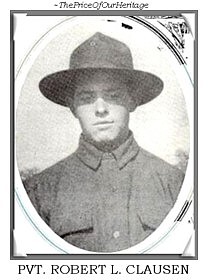
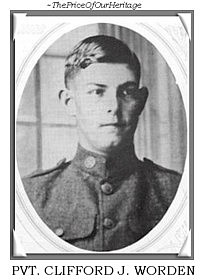
Ben A. Webster was born March 2, 1892, and died June 19, 1965, interment made at Elmwood-St. Joseph
Cemetery.
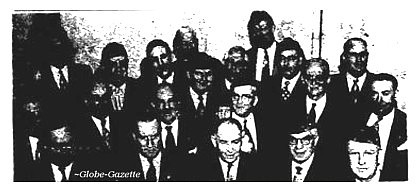
Attending the annual Clausen-Worden post Legion Christmas party in December, 1951, were the above past commanders, including Gen. Hanford MacNider, the first commander, and [H. B.] Hank Hook, then serving as head of the post. Besides Hook, Leo Allstot and Robert Shepard of the War II veterans had served as commanders. From left are: First Row - Roy Kiser, L. R. Whipple, M. V. Clausen, Garrett Chapman and Dr. T. A. Nettleton; Second Row - Frank Bieth; Clarence Kelroy, R. C. Patrick, H. H. Boyce, Gen. MacNider and Elias Kelroy; Third Row - John G. Brown, Fred Wilts, W. D. Lattimer, Shepard, Ralph Lloyd Jones, Roy B. Johnson, W. Earl Hall, Hook, Allstot and Oscar Jewell. NOTE: Leo Allstot was born April 26, 1902, and died
February 25, 1993, interment made at Memorial Park Cemetery, Mason City.
PREVIEW of AIR AGE

[Section 5, Page 13] This Canadian JN4, Mason City's first passenger plane, was purchased in 1919 by the late Josh Melson. Shown from left are Lloyd Sutcliff, George Barrett, Archie Peterson and Mrs. Barrett.
THREE GENERATIONS in BUSINESS
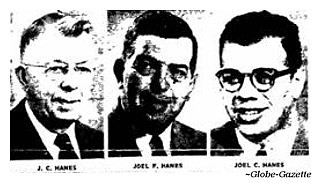
[Section 5, Page 13] It was in 1912 that the late J. C. Hane became a partner of Curtis Yelland in the Yelland and Hanes book and stationery store. He was succeeded in the ownership and management of the store by his son, Joel F. Hanes. The latter's son, Joel C. Hanes II, is now associated with the firm. The store was started on the same site in 1898 by George Penson, who sold out to Curtis Yelland in 1915. J. C. Hanes joined the firm in 1919 and at the death of Mr. Yelland in 1938 became the sole owner of the store. NOTE: Joel C. Hanes, a
Spanish-American War veteran, was born October 3, 1873, and died May 30, 1950.
1920: LIONS CLUB FORMED in MASON CITY MASONS ORGANIZE HARDING LODGE
The following June Westfall was elected district governor at Cedar Rapids, in August, 1921, he was a delegate to the international convention at Oakland, Calif., and at the international convention at Omaha in 1924 he was elected second vice president. The following year he was elected first vice president and in 1926 at San Francisco he was elected International President of Lions Club. NOTE: William A. Westfall was born March 1, 1878, and died August 1, 1965, interment made at Memorial Park Cemetery, Mason City.
In 1929 another Mason city club member was honored in the election of Dr. Starr to the district governorship. The following summer he was elected chairman of the board of govenors and in 1931 a director of Lions International. From its inception the Mason City Lions Club devoted its energies toward assisting boys and girls in need of help. It achieved such distinction that the April 15 issue of Iowa Lion ran a summary of the activities of the club from 1920 under the heading of "What One Lions Club Has Done." In this period the club has made $16,000 in contributions for Kiddies Christmas parties, YMCA boys memberships, relief organizations, boys and girls activities, safety program and other projects. NOTE: Dr. Charles Freeman Starr, M.D. was born December 13, 1876, and died January 28, 1968. There is an Lions Club insignia on his gravestone. He was interred at Memorial Park Cemetery, Mason City. In 1936 C. F. Weaver was elected district governor. In 1939 the club sponsored a homecoming program for Eddie Anderson, Iowa University football coach, with an attendance of 750. Another Mason Cityan was honored with the district governorship in 1942 with the election of Roy Bailey. The past year Don Gilbert has served as zone chairman of the club, continuing the activity that has been a part of the organization for many years, that of assisting in organization of new clubs. NOTE: Charles F. Weaver died March 4, 1964, and was interred at Memorial Park Cemetery, Mason City.
click on your browser's "back" button to return to this webpage. In 1920 the newly organized Mason City Lions Club had this picture taken in front of the Cerro Gordo County Courthouse. From left are: Top Row - E. H. Wagner, D. M. Conroy, Dr. F. G. Carlson, C. E. Gilman, C. G. Maudsley, Clyde Chambers, Dr. C. F. Starr, Paul Wiegand, Lew W. Collins, H. N. Jacoby, W. D. McCaffry, G. O. Gould, Earl Glanville, Dr. J. L. Pauley, Hugh Boyd, G. B. Pray, Fred J. McNeil, J. H. Meyer, A. L. Killmer, Alan C. Lord, Dr. T. A. Burke, C. E. Springer, Tom Cain, Hugh Gilmore, R. E. Nyquist, R. A. Washburn and J. H. McWaters. Lower Row - Harry Lee, R. P. Palmer, Walter Patton, A. J. Marshall, Walter Christensen, Dr. J. M. Daughtery, Jay Beck, the Rev. C. F. Hinton, W. V. Loring, W. A. Westfall, W. E. Groom, J. A. Van Ness, C. L. Loomer, Willis G. C. Bagley, W. L. Nichols, R. B. Martin, Fred Duffield, Carl Jaeger, G. H. Feldman, H. H. Remore, C. E. Bush, Nate S. Sharp, Charles H. Barber and H. C. Fiesner.
ORGANIZE HARDING LODGE IN CITY Harding Lodge No. 649, A.F. & A.M. in Mason City had its origin in 1920 at the time W. A. Westfall was Iowa grandmaster. The matter of organizing another lodge in Mason City came up that year at the grand lodge meeting in Fort Dodge. Final action on the matter took place in 1923 when the grand master, Milo J. Gabriel, was petitioned by 39 signers for the organizing of Harmony Lodge, but when the dispensation was granted on Oct. 23, 1923, Gabriel informed the Mason Cityans the name of the lodge should be Harding in memory of Warren G. Harding, late President of the United States. At the communication of the grand lodge of Iowa held at Des Moines in June, 1924, a charter was granted Harding Lodge and on the following Aug. 14 Past Grand Master Westfall acting for the grand master, constituted the new lodge and installed its officers. The charter officers of the new lodge were: William Glanville, W.M.; G. L. Hutchinson, S.W.; L. L. Sheckler, J.W.; C. C. Halphide, treasurer; James Rae, secretary; Benjamin Bowling, S.D.; Dr. H. K. Jones, J.D.; W. H. Patterson, S.S.; M. O. Davey, J.S.; and H. W. Ditch, tyler. Harding Lodge had grown from 39 to 77 members when the charter night was held. It has continued to increase since until its membership now is approximately 400. Among the interesting events in the lodge's history was the appearance of C. H. McNider before the organization Oct. 30, 1925, to tell of his experiences during a visit to Jerusalem and the Holy Land. He presented to the lodge a gavel, the handle of which came from a cedar of Lebanon and a head of carved rock taken from King Solomon's quarries. This hangs on the wall of the lodge room.
NOTE: William Glanville died November 21, 1931, interment made at Memorial Park Cemetery, Mason City.
1921: BUSINESS WOMEN HERE ORGANIZE WA-TAN-YE CLUB [Section 5, Page 14] On March 10, 1921, eight Mason city business girls held a meeting to organize a service club patterned after Rotary, Lions and Kiwanis clubs for men. The Indian name, "Wa-Tan-Ye," was selected because it meant "Foremost" and the motto of the club became "Service Foremost." Marie Barlow, guiding member in the early organization work, was chosen president; Rena Mack, vice president; Lou Tyson, treasurer; and Alice Kimball, secretary. NOTE: Marie G. (McCabe) Barlow was born in Illinois February, 1898, and died in 1968,
interment made at Clear Lake Cemetery, wife of Franklin R. Barlow (1887 -1969). The first luncheon meeting was held March 15, 1921, to which eight members had invited 25 guests, to whom the president explained the purpose of the club. New members were added to the extent that by the end of the first year the club had a membership of 50. Next came plans for more clubs and on Feb. 27, 1922, a group of 28 Clear Lake business women organized a Wa-Tan-Ye Club. Clubs at Charles City, Storm Lake, Rock Valley and Cherokee were organized in the next two years during the presidency of Mrs. Mary Andrick. In May, 1923, the club started publishing a monthly paper, "The Wa-Tan-Ye." NOTE: Mary C. Andrick was born in 1885, died in 1961, with interment made at Elmwood-St. Joseph Cemetery. She was the wife of George S. C. Andrick (1894 - 1964).
In 1925, with nine clubs organized attention turned to forming an Association of Wa-Tan-Ye Clubs under the leadership of Margaret Bagley, third president of the club. Miss Bagley became first association president, with Mille Beecher as secretary. The first out of the state club to be organized was at Mitchell, S.D. The organization continued to grow until it now [1953] comprises 32 clubs with 870 members in five states. Among the Wa-Tan-Ye services to the community are the following. Providing milk for school children, gifts and food for needy at the Christmas season, glasses for children of needy parents, financial support for nursery school, besides numerous contributions to worthwhile activities.
PIONEER CONTRACTOR
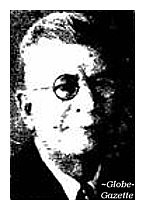
[Section 5, Page 14] Hugh Davey was a pioneer contractor in Mason City and the founder of the Pittsburgh Plate Glass Company and the contracting firm of Hugh Davey and Son. Davey [which was located at 15 2nd Street S.W.], who was born in Beaver Dam, Wis., came to Mason City in 1891, and soon afterwards started in the contracting business, in which he was later joined by his son, Lester P. Davey. NOTE: Hugh Davey was born in 1870, and died in 1936, interment made at Elmwood-St. Joseph Cemetery.
PIONEER LAUNDRYMAN
[Section 5, Page 14] M. J. Lyons started working in laundries here in 1889 when 13 years old. In 1907 he became a partner in the Ideal Laundry and in 1912 purchased the laundry, which he sold in 1915. In 1924 he organized Lyons Launderers and Cleaners, now operated by his son, Roger. His grandson, Mike, is employed in the laundry part time. NOTE: Michael J. Lyons died July 15, 1936, interment was made at Memorial Park Cemetery, Mason City.
1922: VFW POST ORGANIZED in MASON CITY
Reorganization of the post with expanded membership took place in 1933 with Dr. C. L. Marston, a colonel in the medical corps [Field Hospital 38, American Expeditionary Forces] during World War I, as commander. The veterans of the Spanish American War played a large role in this renewed interest. Both Col. Marston and J. W. Beck, who succeeded him as commander, were Spanish American War veterans. NOTE: Col. Marston was born February 6, 1870, and died June 25, 1942. In 1935, the increasing influence of World War I members was recognized with the election of Lowell L. Forbes as commander. In the years that followed the post enjoyed a continuous growth with the following serving as commanders: Seba Vail, 1936-37; Otto Engebretson, 1938; Harry Ditch, 1939; Siert Schoon, 1940; Howard Rieber, 1941; Ed Pearson, 1942; Al L. Carsten, 1943; W. V. Clausen, 1944; Nick Degen, 1945; Ralph J. (Woody) Wilson, 1946; Paul Patschull, 1947; Art O'Green, 1948; Vic Ostby, 1949; Henry Pendergraft, 1950; Dick O'Brien, 1951; and Bob Lundeen elected in 1952.
NOTE: Lowell F. Forbes, veteran of World War I, was born in Greene County, Iowa, on January 17, 1894.
In 1943 the post acquired the Denison Club Building, which had been remodeled to become one of the finest VFW clubs anywhere. With the club are 15 acres of grounds, including adequate parking facilities, a baseball park, playgrounds and picnic grounds. The post entertained the Iowa Department Encampment here in June, 1952, at the largest convention in the department history. Throughout the years the VFW has actively supported and contributed to numerous worthwhile causes such as the Community Chest, March of Dimes, Red Cross, Boy Scouts, Girl Scouts, USO and others. Since World War II, the VFW post has maintained a salaried service officer to facilitate claims of disabled veterans. The local post has received national recognition for its accomplishments and efficiency in this field. The Mason City VFW post has received state and national recognition for its many contributions. It has been the hub of VFW activities in this section of the state and has been instrumental in establishing other VFW posts in Northwood, Osage, Hampton, Sheffield, Kensett, Garner, Britt, Thompson, Kanawha, Clear Lake, Belmond, Iowa Falls and Charles City. On a national level the local post has contributed thousand of dollars for disaster relief, veterans hospitals and the National VFW Home for Children at Eaton Rapids, Mich. NOTE: San Juan Post 733 VFW, located at 1603 South Monroe Avenue, Mason City, maintains a Facebook page.
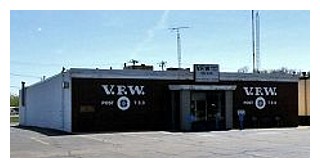
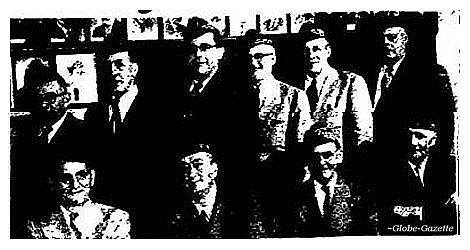
Shown above are the past commanders of San Juan Marne Post of the Veterans of Foreign Wars, from left: Front Row - Rob Roy Cerney, Howard Hushaw, Otto Engebretson and Al L. Carstens; Second Row - W. V. Clausen, Nick Degen, Art O'Green, Vic Ostby, Henry Pendergraft and Bob Lundeen.
1923: MOOSE LODGE FORMS MASON CITY ORGANIZATION
This proved to be the beginning of an active organization that at the present [1953] has nearly 1,000 members. Bert Winter was the first governor. Since 1937 A. C. Clark has been secretary of the local lodge. On two previous occasions, in 1911 and 1915, efforts were made to start a Moose Lodge here, but the organization was disbanded after each attempt. NOTE: Arthur C. Clark was born in 1897, and died in 1963, interment was made at Elmwood-St. Joseph Cemetery.
The Moose Lodge had its beginning June 16, 1888, at St. Louis by a group of theatrical people as an organization of mutual help. The principal aim was to spread true fellowship and foster brotherhood among men. The lodge had a slow beginning and by 1906 had only 246 members. The 247th member was James J. Davis, who joined the lodge that year and rose to leadership. The next 40 years saw the Moose Lodge grow to more than 800,000 members in the United States and Canada, with additional members in Great Britain. David, a native of Wales and a naturalized citizen, rose to national prominence and served as Secretary of Labor under Presidents Harding, Coolidge and Hoover and later became United States Senator from Pennsylvania.
In 1913 the Moose founded Mooseheart, Ill., a combination school and home for dependent children. This community covers 1,200 acres an dis famed as the Child city,the only institution of its kind in the world. Children who have lost their father[s] are accompanied by their mothers to this home. Thus the families are kept together. The expense of the project is borne by the members of the Moose. The average Moose member is a working man in the middle income bracket, yet collectively the members are carrying on a philanthropy worthy of a Rockerfeller. In addition to Mooseheart, the Loyal Order of Moose maintains Moosehaven, a home for old people, at Orange Park, Fla. The year 1923 also saw the organization of the Alliance Gospel Tabernacle and the launching of a most significant project in the Mason city Community Chest, which has raised funds for such projects as the Salvation Army, YMCA, YWCA, Boy Scouts, Girl Scouts, Family Service and the Public Health Nursing Service.
1924: NORTH IOWAN HAD A MAJOR ROLE in EFFORT to SOLVE FARM PROBLEM
Since import duties became ineffective for products for which there was an exportable surplus, some other utilization of the protective principle had to be made. The leading proposal was to protect the price of basic farm products on the home market by dumping abroad the surplus above the domestic demand and assessing the difference between the protected home price and world prices upon the producer by an "equalization fee." In 1924 Rep. Haugen with Sen. C. L. McNary of Oregon introduced the McHary-Haugen bill embodying this plan.At first the plan did not receive sufficient support for congressional approval. But as the problem grew with no other solution in sight the plan got more adherents. In January, 1926, a "Corn and Agricultural Area Conference, a Non-Partisan Gathering to Put Agriculture on a Business Parity With Other Business Enterprises" was called at Des Moines by Gov. John Hammill. Eleven midwest states were represented by 140 delegates. Parity of treatment with industry was the watchword of the meeting. A pointed suggestion was made that if the benefits of the protective tariff were not to apply to agriculture as well as to other industry the whole system would be abolished. The meeting was credited with changing the attitude of many congressmen and in 1927 a revision of the McNary-Haugen bill was passed. It was vetoes by President Coolidge. In 1928 it was passed again only to meet presidential veto.
SCOPE TRIAL KEPT WORLD AGOG in 1925 [Section 5, Page 14] The whole world read with avid interest about the Scopes trial of July, 1925, when evolutionary theories clashed with fundamentalism and the names of William Jennings Bryan, Clarence Darrow, and the entire monkey family were inextricably intertwined. Prof. John T. Scopes, a Dayton, Tenn. teacher, was charged with teaching though forbidden by Tennessee state statute. The judge held the Tennessee law constitutional.
1925: TRACTORS COME to FARMS in NORTH IOWA [Section 5, Page 15] During the life of Mason City, power and equipment on the farm has developed from horse and cast-iron walking plow to the complicated, expensive, fuel-powered machinery of the present day. The development of the multiple-purpose tractor in 1925 marked a tremendous forward step in the evolution of agricultural methods. The Mason City area had a significant part in that development. Mason City became the center for distribution of tractors and other farm implements to a large surrounding territory. Animal power was the main source for the farmer during the 19th century. Until the war between the states in 1860, most of the grass was mowed with a scythe and grain was cut with a sickle or cradle and threshed with a flail. These were called implements of hand production. After the Civil War, labor-saving devices, including the cast-iron plow, the two-row corn planter, the straddle row two-horse cultivator, the mower, the reaper and threshing machines, came into popular use. The tractor symbolized early in the 20th century the revolution about to take place on the farm. This change came on the heels of the auto which revolutionized transportation. The development of the multiple-purpose tractor not only made possible the mechanical cultivation of row crops but also brought about a radical revision in the design of the principle farm machines - which are really appliances attached to the multiple-purpose tractor. In 1933, the introduction of rubber tires as standard equipment increased the efficiency of tractors and made possible their use for hauling other types of equipment along highways at increased speeds. The influence of mechanical power on farming since 1915 has been compared with that which followed the introduction of improved machines with animal power after 1850. Under the impact of two world wars and a postwar rearmament period, mechanical power has accelerated many significant changes on Iowa farms.
KIWANIS CHARTER MEMBERS
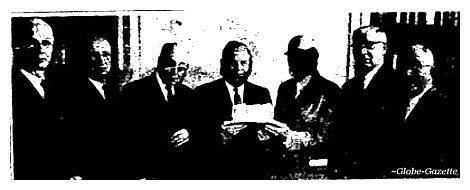
[Section 5, Page 15] Shown above are the charter members of the Mason City Kiwanis Club honored at the club's 33rd birthday early this year. From left are: Carl A. Parker, Dr. Harry F. Pool, Remley J. Glass, Dr. Raymond Kunz (1953 president), George Marty (second president), William Gildner and George E. O'Neil. Charter members not present were Sen. Herman M. Knudson and Dr. George M. Crabb.
STORE STARTED in 1890
NOTE: Ernest A. Engler was born July 16, 1893, and died January 31, 1967. Dorothy C. Engler was born September 20, 1898, and died January 25, 1983. They were interred at Elmwood-St. Joseph Cemetery.
1926: YMCA BUILDING BIG ACHIEVEMENT HISTORIC CENTRAL SCHOOL BURNS [Section 5, Page 15] One of the evidences of Mason City's concern for the building of a finer community was the fact that in the midst of a period of deflation, a campaign got underway to build a YMCA. The building was completed in 1926 at a cost of $250,000 plus $18,000 for equipment, marking the final triumph of a hope that had started in 1892 when the Young Men's Christian Association was organized in Mason City. Although previous efforts had been made to get a building started, it wasn't until the arrival of C. G. Gilman as general secretary June 1, 1921, that effective work for a building got under way.
In June, 1924, a committee composed of Chairman McNider, B. C. Keeler, W. L. Patton, Frank J. Hanlon, W. F. Muse, W. E. Brice and Jay Decker, started a campaign to raise $300,000. By the following September the campaign goal was reached with 3,400 persons signing pledges. While the building was completed in 1926, Chairman McNider refused to turn over the structure to the association until it was free of debt. This took place at a dedication ceremony Dec. 11, 1927. The YMCA board then was made up of W. L. Patton, J. A. Van Ness, George S. Marty, C. G. Maudsley, Jay Decker, Dr. George M. Crabb, W. F. Muse, J. W. Beck, H. J. Steinberg, W. H. Hathorn, Shad Morgan, E. H. Wilcox and J. H. Marston. With the completion of the building there began a program of the association that reached a large number of men and boys. Under Gilman's guidance volunteer leadership was developed.
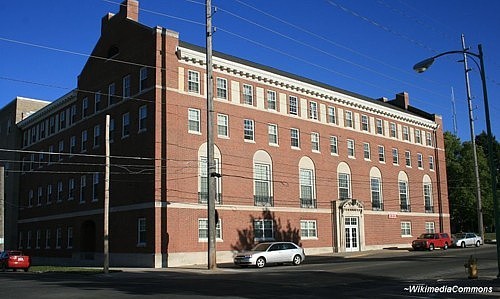
STARTED FURNACE COMPANY
[Section 5, Page 15] Founder of the Kelroy Fuel, Furnace and Plumbing Company is John Kelroy, who started the enterprise in 1926.
1927: LINDBERGH at AIRPORT DEDICATION Mason City's big news story of 1927 was the appearance here of Col. Charles Lindbergh at the dedication of the Legion-Chamber of Commerce 80 acre airport a short distance west of the city. Also here for the occasion was a giant blimp and army flyers from Selfridge Field, Mich. In 1927 Dr. William L. Dibble, president, and the board members of the Kiwanis Club decided that scholarships in High School and Junior College were as deserving of recognition as successes in athletics. This marked the beginning of a new activity for the club which had been organized in 1920, the third of the men's service clubs to be formed. Beginning in 1927 the club has entertained at a dinner each spring the honor students of the Mason City High School and Junior College and the Parochial High Schools. Another service started by the club in 1927 was the giving of boys memberships in the YMCA. This was part of the club's general program of aiding underprivileged and physically handicapped children in the community. Starting in 1936 the club has sponsored a Boy Scout troop. The club aided in the construction of Gaywood Camp for Girl Scouts at Clear Lake. Sixty-four members signed up in the club as charter members upon organization in the fall of 1920. George E. Winter was the first president and James Rae, the initial secretary of the club. In 1940 the Mason City Club entertained the Nebraska-Iowa district convention under the leadership of Lloyd Geer as president of the club and Harlan Girton as chairman of the general convention committee. Mason Cityans who have served as lieutenant-governor of the second division of the district have been Herman M. Knudson, Dr. William L. Dibble, Harry Odle, Dr. W. E. Long, George S. Marty and Roger C. Patton. In 1930 Knudson was district governor after having served as a member of the international committee charged with the promotion and extension. In 1930-31 Knudson served on the international classification and membership committee.
NOTE: William L. Dibble was born in 1865, Columbia County, Wisconsin, and died in 1940, interment
was made at Elmwood-St. Joseph Cemetery.
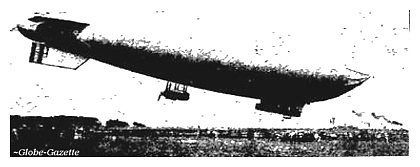
Two hundred men were required to moor this giant blimp as it settled down on Mason City's small pastureland airport Sunday, Aug. 29, 1927. The airport dedication that day included the presence of Col. Charles Lindbergh, fresh from his sensational flight to Paris, and army flyers from Selfridge Field, Detroit.
1928: LOUISE LENNAN NAMED QUEEN MASON CITY CELEBRATES 75th ANNIVERSARY [Section 5, Page 15] Thousands of former residents and old timers came back for the observance of Mason City's 75th anniversary celebration June 17, 18, 19 and 20, 1928. For four days the city was garbed in gala attire commemorating the three-quarters of a century which had passed since John L. McMillin and James Jenkinson built a log cabin on the banks of the Winnebago on the north edge of Mason City. The program included band concerts, parades, sports of the past and present, reunions, dances and other entertainment. Exhibitions of pioneer relics, union services of churches and speeches were included in the four days. Climax of the celebration was the selection of the queen, Miss Louise Lennan, and her two attendants, Miss Marie Buehler and Miss Josephine Houlahan. Miss Lennan is now Mrs. Robert Chambers, and Miss Buehler, Mrs. R. C. Keister, both of Mason City. Miss Houlahan is Mrs. John McDermott of Arlington, Va. NOTE: Marie A. (Buehler) Keister was born June 12, 1905, and died May 16, 1999. Her husband Raymond C. Keister was born May 24, 1903, and died August 1, 1991. They were interred at Memorial Park Cemetery. The program was so successfully presented that it has been referred to repeatedly as plans have gone forward for the observance of the centennial celebration this year. F. G. Duffield was the general chairman of the anniversary program and B. A. Webster, chairman of the parade committee. The parade, depicting the story of transportation from the oxcart to the airplane, included many beautiful floats provided by organizations and business firms. W. L. Patton was the chairman of the homecoming committee. Dr. H. F. Pool was chairman of the historical committee and Mrs. J. E. E. Markley in charge of the collection of relics which were displayed in the windows of downtown stores. NOTE: Fred G. Duffield, general manager of Jacob E. Decker and Sons,
was born May 28, 1883, and died August 16, 1943, interment made at Elmwood-St. Joseph Cemetery.
75th ANNIVERSARY PARADE
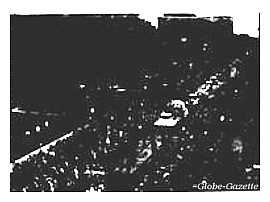
[Section 5, Page 15] This picture looking from First National Bank corner toward the Hotel Hanford shows the 75th anniversary parade coming south on Federal, with crowds lining both sides of the streets and in Central Park to the left.
Unless otherwise noted, photographs courtesy of The Globe-Gazette.
|
Return to Centennial "Age of Horseless Carriage" Index Page Return to Mason City Centennial Index Page Return to History Index Page Return to Cerro Gordo Home Page